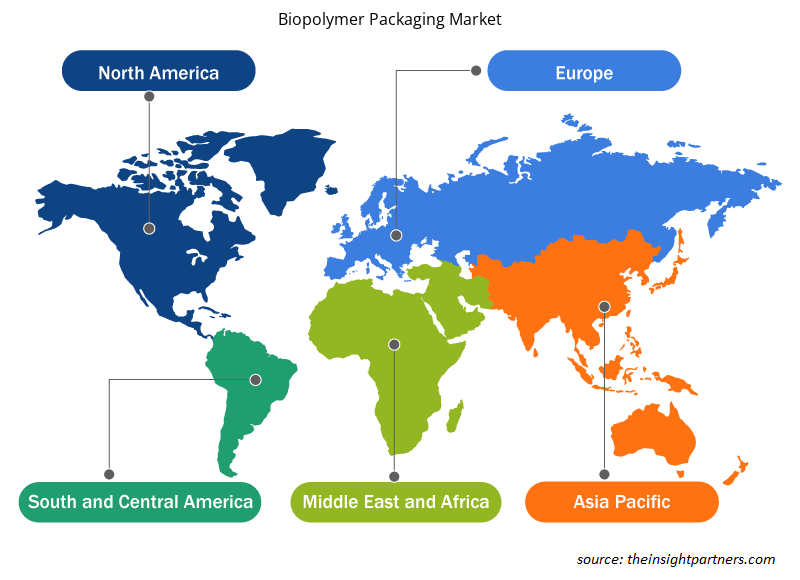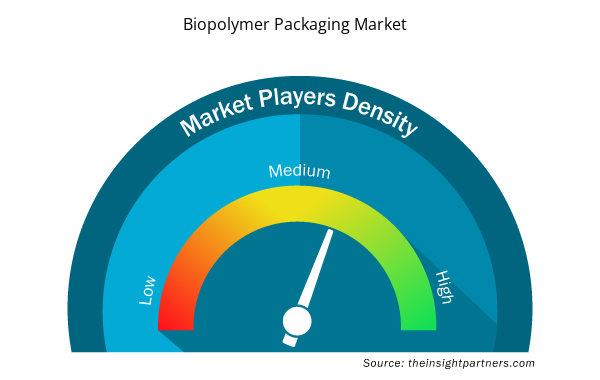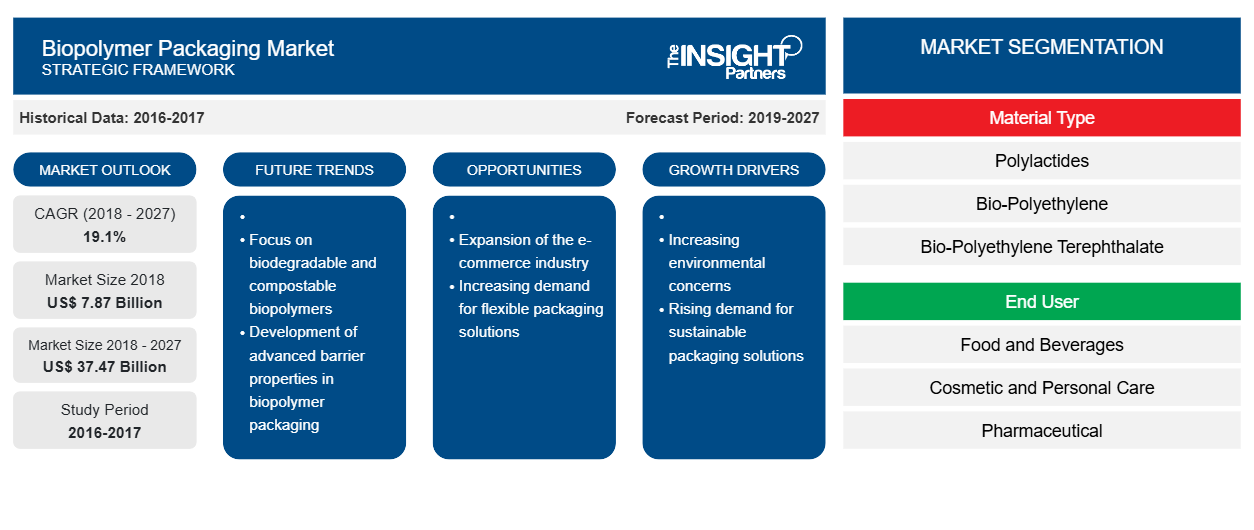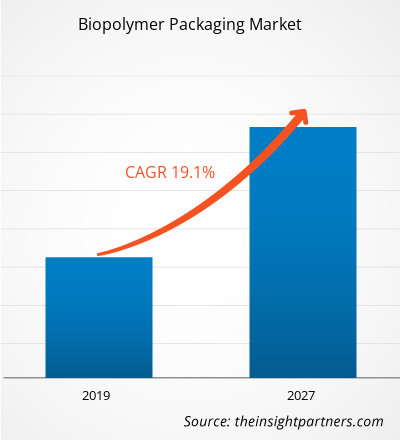2018 年生物聚合物包装市场价值为 78.7254 亿美元,预计到 2027 年将达到 374.6507 亿美元;预计 2019 年至 2027 年的复合年增长率为 19.1%。
生物聚合物是指由淀粉、糖、胶原蛋白、纤维素和其他此类物质组成的可生物降解聚合物。由于食品饮料、个人护理和制药行业的需求不断增长,以及有关在包装中使用合成聚合物的严格规定,生物聚合物在包装应用中的使用日益增多。
由于多项立法、积极的监管努力以及对使用传统塑料包装解决方案的限制,欧洲是生物聚合物包装的主要消费国。法国、意大利和西班牙的有利政府法规有助于在该地区建立积极的生物聚合物包装市场。此外,该地区预计未来几年将增加其生产能力。消费者对可持续产品的需求增加、对研发活动的快速投资以及对生物经济的政治支持是使欧洲成为生物聚合物包装领域突出地区的主要因素。在通过资金和补助金支持创新和研发的政策举措的鼓励下,欧洲生物塑料行业在生物塑料的技术特性和功能方面取得了进展。欧洲已经认识到标准化和认证对于推动包装生物降解性发展的重要性。
2019 年 12 月,COVID-19 疫情起源于武汉(中国),此后迅速蔓延至全球。截至 2020 年 6 月,美国、巴西、印度、俄罗斯、意大利、中国、西班牙、法国和德国是确诊病例和死亡人数最多的国家。由于强制封锁、旅行禁令和企业停业,疫情影响了经济和行业。化工和材料是全球主要行业之一,受疫情影响,该行业面临供应链中断、技术活动取消和办公室关闭等严重中断。由于工厂关闭和供应链出现障碍,COVID-19 导致的全球经济崩溃也影响了生物聚合物包装市场的增长。
定制此报告以满足您的需求
您可以免费定制任何报告,包括本报告的部分内容、国家级分析、Excel 数据包,以及为初创企业和大学提供优惠和折扣
- 获取此报告的关键市场趋势。这个免费样品将包括数据分析,从市场趋势到估计和预测。
市场洞察
可持续包装解决方案需求激增
塑料包装广泛应用于快速消费品、食品和饮料、医药和消费品等各种领域。塑料在多个终端用户行业中的应用日益广泛,导致环境污染加剧。因此,塑料的回收和再利用正成为创新和可持续发展的主要因素。此外,随着原材料来源的减少,传统塑料预计未来会变得更加昂贵。近几年来,生物塑料通过创新影响了塑料行业,以提高资源效率、功能性和可持续性。生物聚合物通过用可再生资源替代石油资源,在提高回收目标和废物管理方面发挥着重要作用。生物聚合物是使用可再生植物资源制造的,这些资源毒性低、可回收性更好、生物降解性高。此外,许多行业参与者正在从化石资源转向生物基材料,以提供可生物降解的包装解决方案。随着人口的增长和需求的增加,包装制造商正在寻找创新方法来满足对可再生塑料日益增长的需求,同时提高产品质量。因此,对可持续包装解决方案的需求增长正在推动全球生物聚合物包装市场的增长。
基于材料类型的洞察
根据材料类型,生物聚合物包装市场细分为聚乳酸 (PLA)、生物聚乙烯 (PE)、生物聚对苯二甲酸乙二醇酯 (PET)、淀粉、纤维素、PBAT、聚羟基脂肪酸酯 (PHA)、聚丁二酸丁二醇酯 (PBS) 等。2018 年,淀粉领域主导了生物聚合物包装市场;然而,预计聚羟基脂肪酸酯 (PHA) 市场在预测期内的复合年增长率最高。淀粉混合物是用于生产生物聚合物的最常见生物质来源。它是一种天然聚合物,由玉米、小麦、大米、大麦、高粱、土豆和其他此类物品制成。淀粉基塑料是热塑性塑料,通过与添加剂和增塑剂(如甘油和山梨糖醇)混合而成。由于淀粉混合物能够通过与许多石油基聚合物或生物聚合物结合来创造独特的复合材料,因此它们在多种应用中得到使用。随着增强型树脂等级的引入以及低毒性、生物相容性以及机械和降解性能的提高,淀粉混合物的重要性日益增加。薄膜和塑料等淀粉基生物聚合物广泛应用于包装行业,用于生产杯子、餐具、鸡蛋盒、吸管、一次性袋子、碗、瓶子、垃圾袋和农业用可堆肥薄膜。
基于最终用户的洞察
根据最终用户,生物聚合物包装市场细分为食品和饮料、化妆品和个人护理、药品和其他。食品和饮料领域占全球生物聚合物包装市场的很大份额;而化妆品和个人护理领域预计在预测期内将实现最快的复合年增长率。食品和饮料应用对淀粉混合物、PLA 等生物聚合物包装的需求预计将上升。随着对可持续性的日益关注,一些食品和饮料制造商已采用基于生物聚合物的包装解决方案来减少温室气体排放。例如,2016 年 10 月,百事可乐与 Danimer Scientific 合作生产 Danimer Scientifics 的可生物降解薄膜树脂,以符合可持续发展的目标。
公司通常会采用多种策略来扩大其全球业务范围。阿科玛集团、巴斯夫 SE、Biome Bioplastics 和 Spectra Packaging 是全球生物聚合物包装市场的主要参与者,它们实施这些策略来扩大客户群并获得显著的市场份额,从而使它们能够在全球范围内保持自己的品牌名称。
生物聚合物包装市场区域洞察
Insight Partners 的分析师已详细解释了预测期内影响生物聚合物包装市场的区域趋势和因素。本节还讨论了北美、欧洲、亚太地区、中东和非洲以及南美和中美洲的生物聚合物包装市场细分和地理位置。

- 获取生物聚合物包装市场的区域特定数据
生物聚合物包装市场报告范围
| 报告属性 | 细节 |
|---|---|
| 2018 年市场规模 | 78.7 亿美元 |
| 2027 年市场规模 | 374.7亿美元 |
| 全球复合年增长率(2018 - 2027) | 19.1% |
| 史料 | 2016-2017 |
| 预测期 | 2019-2027 |
| 涵盖的领域 | 按材料类型
|
| 覆盖地区和国家 | 北美
|
| 市场领导者和主要公司简介 |
|
生物聚合物包装市场参与者密度:了解其对业务动态的影响
生物聚合物包装市场正在快速增长,这得益于终端用户需求的不断增长,而这些需求又源于消费者偏好的不断变化、技术进步以及对产品优势的认识不断提高等因素。随着需求的增加,企业正在扩大其产品范围,进行创新以满足消费者的需求,并利用新兴趋势,从而进一步推动市场增长。
市场参与者密度是指在特定市场或行业内运营的企业或公司的分布情况。它表明在给定市场空间中,相对于其规模或总市场价值,有多少竞争对手(市场参与者)存在。
在生物聚合物包装市场运营的主要公司有:
- 阿科玛集团
- 巴斯夫
- 比奥姆生物塑料有限公司
- 心脏生物塑料
- Innovia 薄膜
免责声明:上面列出的公司没有按照任何特定顺序排列。

- 了解生物聚合物包装市场主要参与者概况
全球生物聚合物包装市场 – 按材料类型
- 聚乳酸(PLA)
- 生物聚乙烯 (PE)
- 生物聚对苯二甲酸乙二醇酯(PET)
- 淀粉
- 纤维素
- PBAT
- 聚羟基脂肪酸酯 (PHA)
- 聚丁二酸丁二醇酯 (PBS)
- 其他的
全球生物聚合物包装市场 – 按最终用户
- 食品和饮料
- 化妆品和个人护理
- 制药
- 其他的
公司简介
- 阿科玛集团
- 巴斯夫
- 比奥姆生物塑料有限公司
- 心脏生物塑料
- Innovia 薄膜
- 自然工程有限公司
- 植物科技有限公司
- Spectra 包装有限公司
- 联合生物聚合物公司
- 陶氏化学公司
- 历史分析(2 年)、基准年、预测(7 年)及复合年增长率
- PEST 和 SWOT 分析
- 市场规模价值/数量 - 全球、区域、国家
- 行业和竞争格局
- Excel 数据集



Report Coverage
Revenue forecast, Company Analysis, Industry landscape, Growth factors, and Trends

Segment Covered
This text is related
to segments covered.

Regional Scope
North America, Europe, Asia Pacific, Middle East & Africa, South & Central America

Country Scope
This text is related
to country scope.
常见问题
With the stringent government regulations for waste management worldwide, the environmental awareness is growing among consumers thus, cosmetic & personal care industry is taking initiatives towards biopolymer packaging. Selecting an appropriate biopolymer packaging is critical for the cosmetic industry as several factors are taken into consideration such as temperature, chemical reactions etc. Further, the development of new technologies have made biopolymers more accessible to packaging manufacturers and suppliers of plastic packaging.
The major players operating in the global biopolymer packaging market are Arkema Group, BASF SE , Biome Bioplastics Limited , Cardia Bioplastics , Innovia Films , NatureWorks LLC, Plantic Technologies Limited , Spectra packaging ltd., United Biopolymers, S.A., The Dow Chemical Company, and BEWiSynbra Group ; among many others.
In 2018, the biopolymer packaging market was predominant in Europe at the global level. The market’s growth is strongly supported by rise in income levels for European population along with continuous research and development, to expand the application base of biopolymer packaging have led to the increased widespread adoption. The popularity of the biopolymer packaging has increased within the region, particularly in Germany, France, UK, and other regions.
Trends and growth analysis reports related to Chemicals and Materials : READ MORE..
The List of Companies - Biopolymer Packaging Market
- Arkema Group
- BASF SE
- Biome Bioplastics Limited
- Cardia Bioplastics
- Innovia Films
- NatureWorks LLC
- Plantic Technologies Limited
- Spectra Packaging Ltd.
- United Biopolymers, S.A.
- The Dow Chemical Company
- BEWiSynbra Group
The Insight Partners performs research in 4 major stages: Data Collection & Secondary Research, Primary Research, Data Analysis and Data Triangulation & Final Review.
- Data Collection and Secondary Research:
As a market research and consulting firm operating from a decade, we have published and advised several client across the globe. First step for any study will start with an assessment of currently available data and insights from existing reports. Further, historical and current market information is collected from Investor Presentations, Annual Reports, SEC Filings, etc., and other information related to company’s performance and market positioning are gathered from Paid Databases (Factiva, Hoovers, and Reuters) and various other publications available in public domain.
Several associations trade associates, technical forums, institutes, societies and organization are accessed to gain technical as well as market related insights through their publications such as research papers, blogs and press releases related to the studies are referred to get cues about the market. Further, white papers, journals, magazines, and other news articles published in last 3 years are scrutinized and analyzed to understand the current market trends.
- Primary Research:
The primarily interview analysis comprise of data obtained from industry participants interview and answers to survey questions gathered by in-house primary team.
For primary research, interviews are conducted with industry experts/CEOs/Marketing Managers/VPs/Subject Matter Experts from both demand and supply side to get a 360-degree view of the market. The primary team conducts several interviews based on the complexity of the markets to understand the various market trends and dynamics which makes research more credible and precise.
A typical research interview fulfils the following functions:
- Provides first-hand information on the market size, market trends, growth trends, competitive landscape, and outlook
- Validates and strengthens in-house secondary research findings
- Develops the analysis team’s expertise and market understanding
Primary research involves email interactions and telephone interviews for each market, category, segment, and sub-segment across geographies. The participants who typically take part in such a process include, but are not limited to:
- Industry participants: VPs, business development managers, market intelligence managers and national sales managers
- Outside experts: Valuation experts, research analysts and key opinion leaders specializing in the electronics and semiconductor industry.
Below is the breakup of our primary respondents by company, designation, and region:

Once we receive the confirmation from primary research sources or primary respondents, we finalize the base year market estimation and forecast the data as per the macroeconomic and microeconomic factors assessed during data collection.
- Data Analysis:
Once data is validated through both secondary as well as primary respondents, we finalize the market estimations by hypothesis formulation and factor analysis at regional and country level.
- Macro-Economic Factor Analysis:
We analyse macroeconomic indicators such the gross domestic product (GDP), increase in the demand for goods and services across industries, technological advancement, regional economic growth, governmental policies, the influence of COVID-19, PEST analysis, and other aspects. This analysis aids in setting benchmarks for various nations/regions and approximating market splits. Additionally, the general trend of the aforementioned components aid in determining the market's development possibilities.
- Country Level Data:
Various factors that are especially aligned to the country are taken into account to determine the market size for a certain area and country, including the presence of vendors, such as headquarters and offices, the country's GDP, demand patterns, and industry growth. To comprehend the market dynamics for the nation, a number of growth variables, inhibitors, application areas, and current market trends are researched. The aforementioned elements aid in determining the country's overall market's growth potential.
- Company Profile:
The “Table of Contents” is formulated by listing and analyzing more than 25 - 30 companies operating in the market ecosystem across geographies. However, we profile only 10 companies as a standard practice in our syndicate reports. These 10 companies comprise leading, emerging, and regional players. Nonetheless, our analysis is not restricted to the 10 listed companies, we also analyze other companies present in the market to develop a holistic view and understand the prevailing trends. The “Company Profiles” section in the report covers key facts, business description, products & services, financial information, SWOT analysis, and key developments. The financial information presented is extracted from the annual reports and official documents of the publicly listed companies. Upon collecting the information for the sections of respective companies, we verify them via various primary sources and then compile the data in respective company profiles. The company level information helps us in deriving the base number as well as in forecasting the market size.
- Developing Base Number:
Aggregation of sales statistics (2020-2022) and macro-economic factor, and other secondary and primary research insights are utilized to arrive at base number and related market shares for 2022. The data gaps are identified in this step and relevant market data is analyzed, collected from paid primary interviews or databases. On finalizing the base year market size, forecasts are developed on the basis of macro-economic, industry and market growth factors and company level analysis.
- Data Triangulation and Final Review:
The market findings and base year market size calculations are validated from supply as well as demand side. Demand side validations are based on macro-economic factor analysis and benchmarks for respective regions and countries. In case of supply side validations, revenues of major companies are estimated (in case not available) based on industry benchmark, approximate number of employees, product portfolio, and primary interviews revenues are gathered. Further revenue from target product/service segment is assessed to avoid overshooting of market statistics. In case of heavy deviations between supply and demand side values, all thes steps are repeated to achieve synchronization.
We follow an iterative model, wherein we share our research findings with Subject Matter Experts (SME’s) and Key Opinion Leaders (KOLs) until consensus view of the market is not formulated – this model negates any drastic deviation in the opinions of experts. Only validated and universally acceptable research findings are quoted in our reports.
We have important check points that we use to validate our research findings – which we call – data triangulation, where we validate the information, we generate from secondary sources with primary interviews and then we re-validate with our internal data bases and Subject matter experts. This comprehensive model enables us to deliver high quality, reliable data in shortest possible time.


 获取此报告的免费样本
获取此报告的免费样本